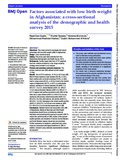Factors associated with low birth weight in Afghanistan: A cross-sectional analysis of the demographic and health survey 2015

View/Open
Date
2019-05-14Publisher
BMJ OpenAuthor
Gupta, Rajat DasSwasey, Krystal
Burrowes, Vanessa
Hashan, Mohammad Rashidul
Al Kibria, Gulam Muhammed
Metadata
Show full item recordCitation
Gupta, R. D., Swasey, K., Burrowes, V., Hashan, M. R., & Al Kibria, G. M. (2019). Factors associated with low birth weight in Afghanistan: A cross-sectional analysis of the demographic and health survey 2015. BMJ Open, 9(5) doi:10.1136/bmjopen-2018-025715Abstract
Objectives This study aimed to investigate the factors associated with low birth weight (LBW) in Afghanistan.
Design Cross-sectional study.
Setting This study used data collected from the Afghanistan Demographic and Health Survey 2015.
Participants Facility-based data from 2773 weighted live-born children enrolled by a two-stage sampling strategy were included in our analysis.
Primary and secondary outcome measures The primary outcome was LBW, defined as birth weight <2.5kg.
Results Out of 2773 newborns, 15.5% (n=431) had LBW. Most of these newborns were females (58.3%, n=251), had a mother with no formal schooling (70.5%, n=304), lived in urban areas (63.4%, n=274) or lived in the Central region of Afghanistan (59.7%, n=257). In multivariable analysis, residence in Central (adjusted OR (AOR): 3.4; 95% CI 1.7 to 6.7), Central Western (AOR: 3.0; 95% CI 1.5 to 5.8) and Southern Western (AOR: 4.0; 95% CI 1.7 to 9.1) regions had positive association with LBW. On the other hand, male children (AOR: 0.5; 95% CI 0.4 to 0.8), newborns with primary maternal education (AOR: 0.5; 95% CI 0.3 to 0.8), birth interval ≥48 months (AOR: 0.4; 95% CI 0.1 to 0.8), belonging to the richest wealth quintile (AOR: 0.2; 95% CI 0.1 to 0.6) and rural residence (AOR: 0.3; 95% CI 0.2 to 0.6) had decreased odds of LBW.
Conclusions Multiple factors had association with LBW in Afghanistan. Maternal, Neonatal and Child Health programmes should focus on enhancing maternal education and promoting birth spacing to prevent LBW. To reduce the overall burden of LBW, women of the poorest wealth quintiles, and residents of Central, Central Western and South Western regions should also be prioritised. Further exploration is needed to understand why urban areas are associated with higher likelihood of LBW. In addition, research using nationally representative samples are required.
This is an open access article distributed in accordance with the Creative Commons Attribution Non Commercial (CC BY-NC 4.0) license, which permits others to distribute, remix, adapt, build upon this work non-commercially, and license their derivative works on different terms, provided the original work is properly cited, appropriate credit is given, any changes made indicated, and the use is non-commercial.
